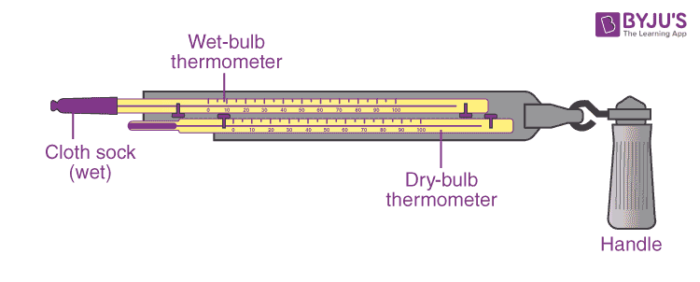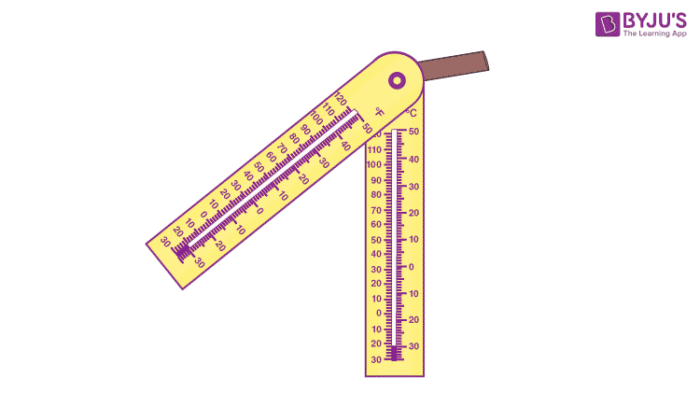What is Psychrometer?
A psychrometer is a hygrometer made up of two thermometers that are identical. One thermometer’s bulb is kept wet, causing it to record a lower temperature than the dry-bulb thermometer due to evaporation cooling.
A psychrometer is a device for measuring air humidity. It does so by measuring the temperature difference between a dry thermometer bulb and a wet thermometer bulb that has lost some moisture due to evaporation.
Table of Contents
- Sling Psychrometer
- Design of Psychrometer
- Working of Psychrometer
- Uses of Psychrometer
- Frequently Asked Questions – FAQs
A psychrometer tests both the dry and wet bulb temperatures at the same time. A wet wick mounted over the thermometer bulb is used to determine the temperature of the wet bulb. Practically any kind of thermometer can be used.
Sling Psychrometer
The relative humidity, which is calculated as a percentage, can be determined using a sling psychrometer. It’s calculated by multiplying the amount of moisture in the air at a given temperature by the maximum amount of moisture the air could hold at the same temperature, dividing by 100, and multiplying the quotient by 100.
A wet-bulb thermometer and a dry-bulb thermometer are kept in a sling psychrometer. Using regular tables and maps, a sling psychrometer may be used to calculate the physical and thermal properties of moist air. It’s usually used to figure out relative humidity.

The wet bulb is covered in muslin, which is soaked in water and acts as a wick. When the web bulb is removed from the bath, it cools due to evaporation. A sling psychrometer is one that has the bulb whirled around to speed up evaporation.
Design of Psychrometer
A wet-bulb thermometer and a dry-bulb thermometer are kept in a sling psychrometer. Psychrometric charts are complicated graphs that show the dry-bulb temperature, wet-bulb temperature, relative humidity, specific volume, dew point temperature, humidity ratio, and enthalpy of moist air at a specific atmospheric pressure.
A dry-bulb thermometer is a regular thermometer, while a wet-bulb thermometer is one with a cloth-wrapped bulb that has been moistened with distilled water. One bulb is dripping wet, while the other is completely dry. To test the temperature, we expose the dry bulb to the cold. We wrap a cloth wick around the wet bulb and soak it in water until it’s ready to use.
Working of Psychrometer
The amount of evaporative cooling on the psychrometer’s wet bulb is proportional to the amount of moisture in the air. Drier air absorbs more moisture from the bulb, which causes it to cool down faster. The temperature does not change as much because the warmer air cannot retain as much water from the bulb. In other words, the more humid the air is, the greater the change in the wet bulb temperature.
Much information about atmospheric conditions, such as humidity, air temperature, surface temperature, and dew point, can be shown on a digital screen at once. However, these devices must be calibrated to local conditions for 20 to 30 minutes before use, and the wet bulb sensor will dry out if not used for a prolonged period of time.
As a result, despite needing a little more legwork on the part of the user, the good old manual psychrometer retains its appeal. They would use a psychrometric chart to determine the final humidity reading after reading both bulb temperatures.
Uses of Psychrometer
While psychrometers are no longer widely used, they are still sometimes used to calibrate humidistats, which regulate the internal humidity of air conditioning and heating systems in buildings. Psychrometers were once used in the construction of building ventilation systems.
A psychrometer tests both the dry and wet bulb temperatures at the same time. A wet wick mounted over the thermometer bulb is used to determine the temperature of the wet bulb. Practically any kind of thermometer can be used.
In some ships, the primary wet bulb temperature measurement system is an electric psychrometer. They use it as a backup for air temperature and dew point sensors that are automatically mounted.
Psychrometers are used for musical instruments such as pianos, guitars, and violins, which can be affected by excessive humidity. Paints are susceptible to humidity, so it’s used in the coating industry.
Frequently Asked Questions – FAQs
How do you read wet bulb temperature?
The temperature of a wet bulb can be determined with a thermometer and the bulb is covered in wet muslin. The cooling effect of adiabatic evaporation of water from the thermometer is indicated by a “wet bulb temperature” in the air that is lower than the dry bulb temperature.
What unit does a psychrometer measure in?
Electronegativity is a function of an atom’s ability to attract an electron binding pair. The most frequently used is the Pauling scale. Fluorine is assigned a value of 4.0, and values that are the least electronegative at 0.7 range down to cesium and francium.
How does a slingshot psychrometer measure relative humidity?
A hygrometer is an instrument that can be used to measure relative humidity. The simplest hygrometer is a sling psychrometer, which consists of two thermometers connected by a chain and a handle. Water evaporates from the wick during the whirling, cooling the wet-bulb thermometer.
What is used to measure humidity?
A hygrometer is a device that measures relative humidity levels. The amount of moisture in the air is measured by humidity. A psychrometer, for example, is a type of hygrometer.
How do you calculate relative humidity using a psychrometer?
The relative humidity, which is calculated as a percentage, can be determined using a sling psychrometer. It’s calculated by multiplying the amount of moisture in the air at a given temperature by the maximum amount of moisture the air could hold at the same temperature, dividing by 100, and multiplying the quotient by 100.


Comments